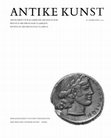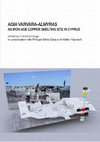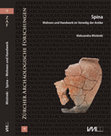Papers by Aleksandra Mistireki
Antike Kunst, 2021
Les activités de l'École suisse d'archéologie en Grèce en 2020. L'Artémision d'Amarynthos (pl. 20... more Les activités de l'École suisse d'archéologie en Grèce en 2020. L'Artémision d'Amarynthos (pl. 20). .. .. .. .
Antike Kunst, 2021
Les activités de l'École suisse d'archéologie en Grèce en 2020. L'Artémision d'Amarynthos (pl. 20... more Les activités de l'École suisse d'archéologie en Grèce en 2020. L'Artémision d'Amarynthos (pl. 20). .. .. .. .
Bulletin der Schweizer Arbeitsgemeinschaft für Klassische Archäologie, 2020
Bulletin der Schweizer Arbeitsgemeinschaft für Klassische Archäologie, 2019
L. Zamboni, M. Fernández-Götz & C. Metzner-Nebelsick (eds) 2020: Crossing the Alps. Early Urbanism between Northern Italy and Central Europe (900-400 BC), Leiden: Sidestone Press, 2020
Cover image: LandesamtfürDenkmalpflegeimRegierungsprӓsidiumStuttgart;FaberCourtial Section images... more Cover image: LandesamtfürDenkmalpflegeimRegierungsprӓsidiumStuttgart;FaberCourtial Section images: Karsten Wentink Backcoverimage:MuseoDeltaAnticoComacchio;InkLink ISBN 978-90-8890-961-0 (softcover) ISBN 978-90-8890-962-7 (hardcover) ISBN978-90-8890-963-4(PDFe-book)

Antike Kunst 62, 2019
In Spina konnte erstmals der Nachweis der griechischen «batterie de cuisine» in einer etruskische... more In Spina konnte erstmals der Nachweis der griechischen «batterie de cuisine» in einer etruskischen Siedlung und nördlich des Apennins erbracht werden. Die Leitform der griechischen Kochkeramik schlechthin ist die Lopas. Ein flacher Kochtopf mit weiter Mündung, dessen Rand innen mit einer Deckelleiste versehen ist. Die Gefässform entsteht im 5. Jh. v. Chr. Ab klassischer, v. a. aber hellenistischer Zeit findet die Gefässform eine maximale Verbreitung von der Levante bis nach Marseille. Eine Vielzahl neuer Produktionsorte entsteht, aber auch lokale Imitationen in den für die einheimischen Kochtöpfe üblicherweise verwendeten Tonsorten. Zeitgleich mit der neuen Gefässform lässt sich in den antiken Schriftquellen ein entscheidender Einschnitt in den Essgewohnheiten feststellen. Dies wirft Fragen nach einer möglichen Übernahme griechischer kulinarischer Sitten und einer bedingten Akkulturation auf.
Die Untersuchung der Lopades der Zürcher Grabung konnte durch eine auf technischen Merkmalen beruhenden Typologie neue Einblicke in die Herstellung der Lopades und deren Entwicklung liefern. Naturwissenschaftliche Analysen ergänzen das Bild und geben Hinweise zu den damaligen Essensgewohnheiten. In der etruskischen Stadt Spina fällt zudem die nur partiell erfolgte Übernahme des griechischen Kochsets und eine starke Vermischung indigener und fremder Elemente auf. Anhand des Fundmaterials aus einem Zerstörungshorizont soll dies näher betrachtet werden.

Agia Varvara - Almyras. An Iron Age Copper Smelting Site in Cyprus, 2018
The Iron Age copper smelting site situated near the Cypriot village Agia Varvara is of particular... more The Iron Age copper smelting site situated near the Cypriot village Agia Varvara is of particular importance among the ancient copper processing places in the Near East because it has revealed spatial as well as technological aspects of copper production in a hitherto rarely-seen depth of detail. Agia Varvara-Almyras: an Iron Age Copper Smelting Site in Cyprus presents the results of a comprehensive post-excavation analysis of the stratigraphy (part I), also of the geology, metallurgical materials (furnaces, tuyeres), finds (pottery, furnace lining, stone tools), as well as a synthesis of the copper smelting technology at Agia Varvara-Almyras (part II).The excavation analysis not only focuses on pyrotechnical information from individual furnaces, but also provides a detailed study of the spatial organisation as well as of the living conditions on the smelting site. An elaborate reconstruction of the features in a 3D model allows the visualisation of formerly-dispersed loci of copper production. Based on this virtual rebuilding of the hillock named Almyras, it becomes clear that archaeometallurgy must be unchained, and the idea of an ‘operational chain’ must be replaced by a more multidimensional research strategy labelled as an ‘operational web’. The present volume aims to stimulate future excavations which pay attention to the reasons behind the exploitation of the riches of the island, as well as to the needs of the markets where the final product was very likely to have been appreciated as a strategic commodity, by power players operating on the island as well as by ordinary people in need of a repair to an everyday commodity which had broken.
Edited Journals by Aleksandra Mistireki

Bulletin SAKA-ASAC, 2021
Trotz allen pandemiebedingen Schwierigkeiten und Unsicherheiten kann zum Ende des Jahres 2021 hin... more Trotz allen pandemiebedingen Schwierigkeiten und Unsicherheiten kann zum Ende des Jahres 2021 hin eine eindrückliche Bilanz zu den Aktivitäten der Schweizer Klassischen Archäologie gezogen werden. Feldarchäologie Sowohl in Italien wie auch in Griechenland wurde die Feldarbeit im Vergleich zum Vorjahr während den im Hinblick auf die Pandemie eher ruhigen Sommermonaten wieder intensiviert, wenn auch mit teils sehr strengen Schutzmassnahmen (Abb. 1). Die Projekte haben in den Zeitungen und im Fernsehen für Schlagzeilen gesorgt, in der Schweiz und auch im Ausland (Abb. 3). Auf dem Monte Iato in Sizilien konnte die Universität Zürich im Rahmen des SNF-Projektes «Becoming Roman-Die Neubewertung des zentralen Stadtraumes der hellenistisch-römischen Stadt Iaitas/Ietas (Palermo/Sizilien)» eine einmonatige Grabungskampagne im August durchführen (Abb. 2), gefolgt von zwei Wochen Nacharbeit. Im Fokus stand das Post-Doc-Projekt von Alexandra Tanner zur Architektur der Nordhalle und zur urbanistischen Entwicklung der Agora.
Call for Papers by Aleksandra Mistireki
International Conferences by Aleksandra Mistireki
Das 21. Treffen der Etrusker & Italiker AG des dArV e.V. findet vom 03. bis 04. Februar 2023 in Z... more Das 21. Treffen der Etrusker & Italiker AG des dArV e.V. findet vom 03. bis 04. Februar 2023 in Zusammenarbeit mit dem Fachbereich Klassische Archäologie der Universitäten Basel und Zürich statt. Thema des Basler Workshops ist die Keramik im etruskischen und italischen Raum in einer kontextbezogenen Perspektive.
Books by Aleksandra Mistireki

The Zurich excavations in Spina [2008-2017] brought to light several settlement phases from the e... more The Zurich excavations in Spina [2008-2017] brought to light several settlement phases from the end of the 6th to the end of the 4th century B.C. The present volume is dedicated to the remains of the most recent phase, a house destroyed during a military conflict and its completely preserved inventory of the 4th century B.C. In addition to the evaluation of the architectural remains, the findings are also presented in their entirety, focusing on the so-called utilitarian pottery, which has hardly been considered in research to date. Based on the analysis of the findings, conclusions are drawn about the organisation of the household as well as the consumer behaviour and the social position of the inhabitants. In addition, the function, typological development, method of production, chronological development and origin of the ceramic findings are examined. The investigations in Spina, historically the most important trading centre on the Italian Adriatic coast, have added new data on the material and social network in the Mediterranean to the previously only sparsely documented 4th century B.C. in the Po Valley. Thanks to the excellent preservation conditions and the undisturbed features, the study makes an important contribution to the chronological classification and typological development of Etruscan pottery and the settlement system of this period.
Conference Presentations and Abstracts by Aleksandra Mistireki











Uploads
Papers by Aleksandra Mistireki
Die Untersuchung der Lopades der Zürcher Grabung konnte durch eine auf technischen Merkmalen beruhenden Typologie neue Einblicke in die Herstellung der Lopades und deren Entwicklung liefern. Naturwissenschaftliche Analysen ergänzen das Bild und geben Hinweise zu den damaligen Essensgewohnheiten. In der etruskischen Stadt Spina fällt zudem die nur partiell erfolgte Übernahme des griechischen Kochsets und eine starke Vermischung indigener und fremder Elemente auf. Anhand des Fundmaterials aus einem Zerstörungshorizont soll dies näher betrachtet werden.
Edited Journals by Aleksandra Mistireki
Call for Papers by Aleksandra Mistireki
International Conferences by Aleksandra Mistireki
Books by Aleksandra Mistireki
Conference Presentations and Abstracts by Aleksandra Mistireki
Die Untersuchung der Lopades der Zürcher Grabung konnte durch eine auf technischen Merkmalen beruhenden Typologie neue Einblicke in die Herstellung der Lopades und deren Entwicklung liefern. Naturwissenschaftliche Analysen ergänzen das Bild und geben Hinweise zu den damaligen Essensgewohnheiten. In der etruskischen Stadt Spina fällt zudem die nur partiell erfolgte Übernahme des griechischen Kochsets und eine starke Vermischung indigener und fremder Elemente auf. Anhand des Fundmaterials aus einem Zerstörungshorizont soll dies näher betrachtet werden.